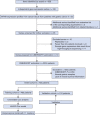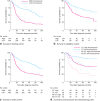Gene expression profiles for a prognostic immunoscore in gastric cancer
- PMID: 29691839
- PMCID: PMC6099214
- DOI: 10.1002/bjs.10871
Gene expression profiles for a prognostic immunoscore in gastric cancer
Abstract
Background: Increasing evidence has indicated an association between immune infiltration in gastric cancer and clinical outcome. However, reliable prognostic signatures, based on systematic assessments of the immune landscape inferred from bulk tumour transcriptomes, have not been established. The aim was to develop an immune signature, based on the cellular composition of the immune infiltrate inferred from bulk tumour transcriptomes, to improve the prognostic predictions of gastric cancer.
Methods: Twenty-two types of immune cell fraction were estimated based on large public gastric cancer cohorts from the Gene Expression Omnibus using CIBERSORT. An immunoscore based on the fraction of immune cell types was then constructed using a least absolute shrinkage and selection operator (LASSO) Cox regression model.
Results: Using the LASSO model, an immunoscore was established consisting of 11 types of immune cell fraction. In the training cohort (490 patients), significant differences were found between high- and low-immunoscore groups in overall survival across and within subpopulations with an identical TNM stage. Multivariable analysis revealed that the immunoscore was an independent prognostic factor (hazard ratio 1·92, 95 per cent c.i. 1·54 to 2·40). The prognostic value of the immunoscore was also confirmed in the validation (210) and entire (700) cohorts.
Conclusion: The proposed immunoscore represents a promising signature for estimating overall survival in patients with gastric cancer.
© 2018 The Authors. BJS published by John Wiley & Sons Ltd on behalf of BJS Society Ltd.
Figures




Comment in
-
Comment on: Gene expression profiles for a prognostic immunoscore in gastric cancer.Br J Surg. 2019 Sep;106(10):1416. doi: 10.1002/bjs.11317. Br J Surg. 2019. PMID: 31414717 No abstract available.
Similar articles
-
An Immune Cell Signature Is Associated With Disease-Free Survival and Adjuvant Chemosensitivity of Patients With Resectable Gastric Cancer.Front Immunol. 2021 Feb 4;11:621623. doi: 10.3389/fimmu.2020.621623. eCollection 2020. Front Immunol. 2021. PMID: 33613554 Free PMC article.
-
Significance of tumor-infiltrating immunocytes for predicting prognosis of hepatitis B virus-related hepatocellular carcinoma.World J Gastroenterol. 2019 Sep 21;25(35):5266-5282. doi: 10.3748/wjg.v25.i35.5266. World J Gastroenterol. 2019. PMID: 31558872 Free PMC article.
-
A Four-Factor Immunoscore System That Predicts Clinical Outcome for Stage II/III Gastric Cancer.Cancer Immunol Res. 2017 Jul;5(7):524-534. doi: 10.1158/2326-6066.CIR-16-0381. Epub 2017 Jun 15. Cancer Immunol Res. 2017. PMID: 28619967
-
[Intratumoral immune microenvironment and survival: the immunoscore].Med Sci (Paris). 2014 Apr;30(4):439-44. doi: 10.1051/medsci/20143004020. Epub 2014 May 5. Med Sci (Paris). 2014. PMID: 24801041 Review. French.
-
Rational bases for the use of the Immunoscore in routine clinical settings as a prognostic and predictive biomarker in cancer patients.Int Immunol. 2016 Aug;28(8):373-82. doi: 10.1093/intimm/dxw021. Epub 2016 Apr 27. Int Immunol. 2016. PMID: 27121213 Free PMC article. Review.
Cited by
-
The Diagnostic and Immunotherapeutic Value of CD248 in Renal Cell Carcinoma.Front Oncol. 2021 Mar 12;11:644612. doi: 10.3389/fonc.2021.644612. eCollection 2021. Front Oncol. 2021. PMID: 33791227 Free PMC article.
-
Mucosal microbiota characterization in gastric cancer identifies immune-activated-related transcripts relevant gastric microbiome signatures.Front Immunol. 2024 Sep 23;15:1435334. doi: 10.3389/fimmu.2024.1435334. eCollection 2024. Front Immunol. 2024. PMID: 39376571 Free PMC article.
-
Seven-Gene Signature Based on Glycolysis Is Closely Related to the Prognosis and Tumor Immune Infiltration of Patients With Gastric Cancer.Front Oncol. 2020 Sep 18;10:1778. doi: 10.3389/fonc.2020.01778. eCollection 2020. Front Oncol. 2020. Retraction in: Front Oncol. 2024 Sep 17;14:1490596. doi: 10.3389/fonc.2024.1490596. PMID: 33072557 Free PMC article. Retracted.
-
CSF1R is a Prognostic Biomarker and Correlated with Immune Cell Infiltration in the Gastric Cancer Microenvironment.Pharmgenomics Pers Med. 2021 Apr 13;14:445-457. doi: 10.2147/PGPM.S301303. eCollection 2021. Pharmgenomics Pers Med. 2021. PMID: 33880056 Free PMC article.
-
Prognostic value and underlying mechanism of autophagy-related genes in bladder cancer.Sci Rep. 2022 Feb 9;12(1):2219. doi: 10.1038/s41598-022-06334-0. Sci Rep. 2022. PMID: 35140317 Free PMC article.
References
-
- Jiang Y, Zhang Q, Hu Y, Li T, Yu J, Zhao L et al ImmunoScore signature: a prognostic and predictive tool in gastric cancer. Ann Surg 2018; 267: 504–513. - PubMed
-
- Zhang R, Li F, Li H, Yu J, Ren X. The clinical significance of memory T cells and its subsets in gastric cancer. Clin Transl Oncol 2014; 16: 257–265. - PubMed
MeSH terms
Substances
LinkOut - more resources
Full Text Sources
Other Literature Sources
Medical

